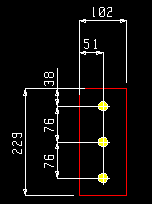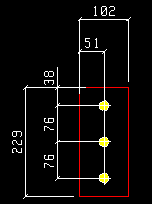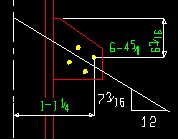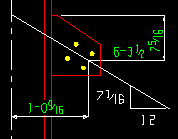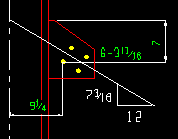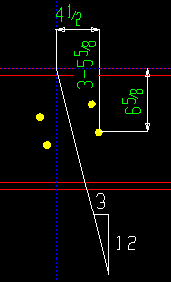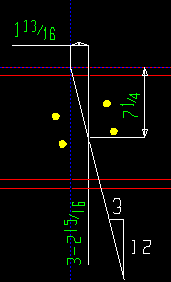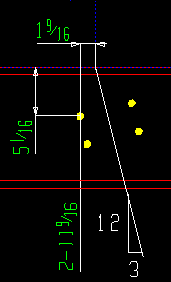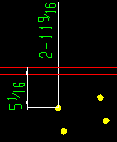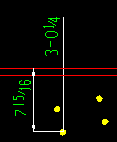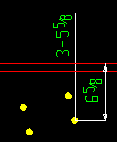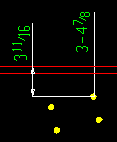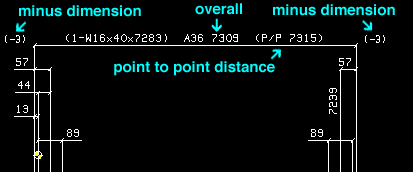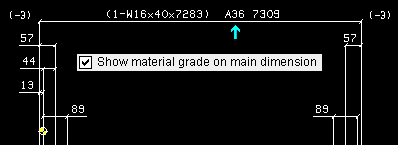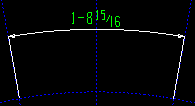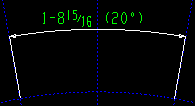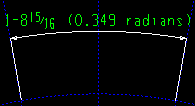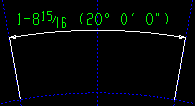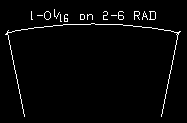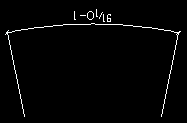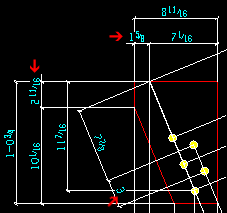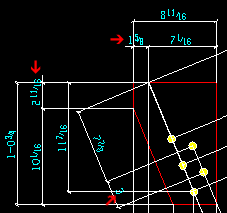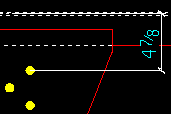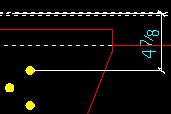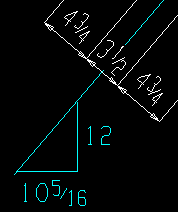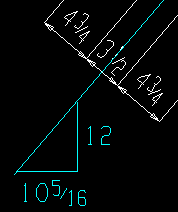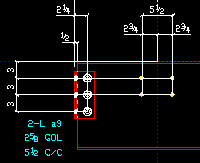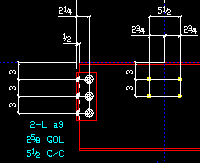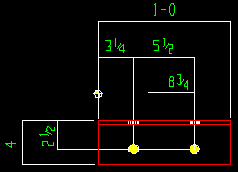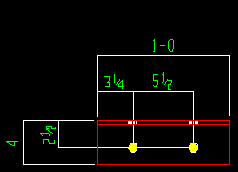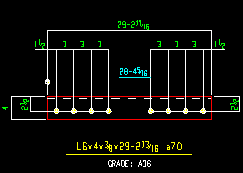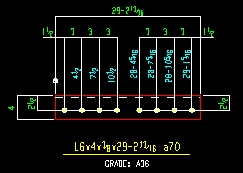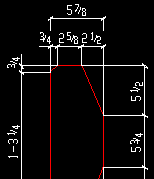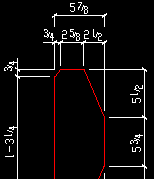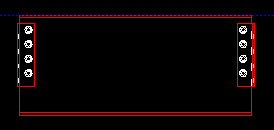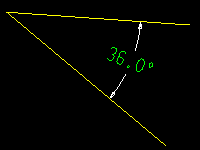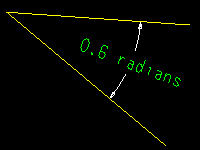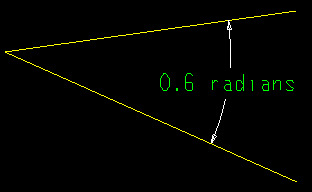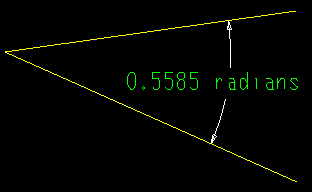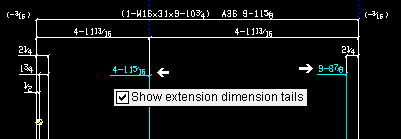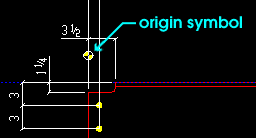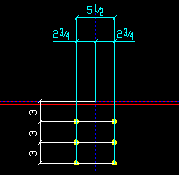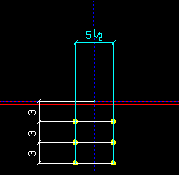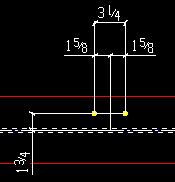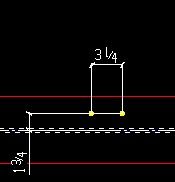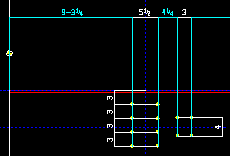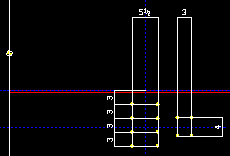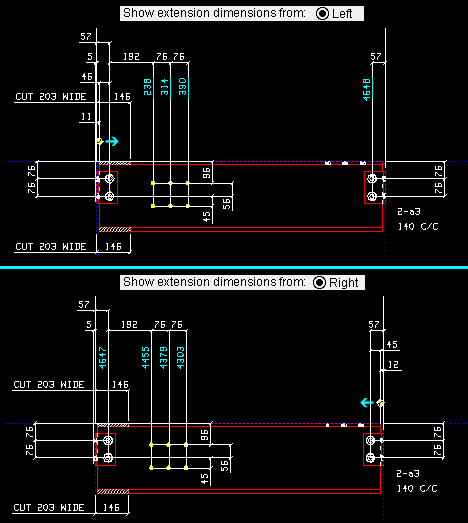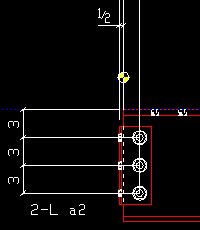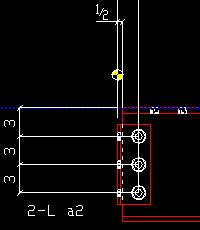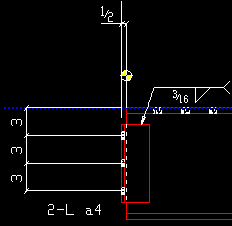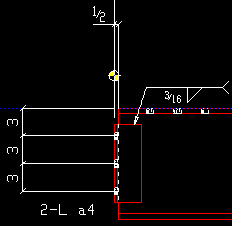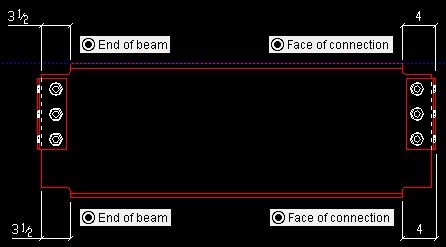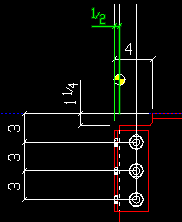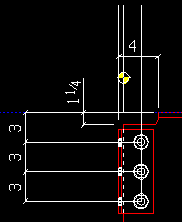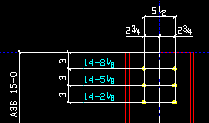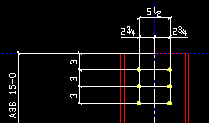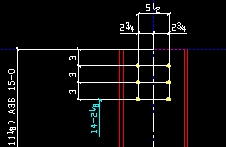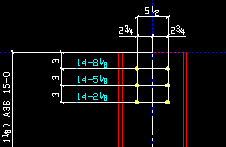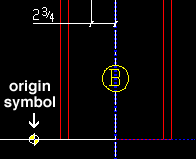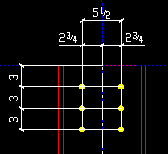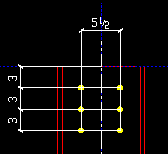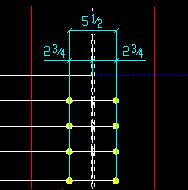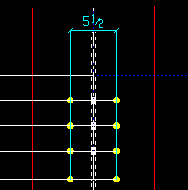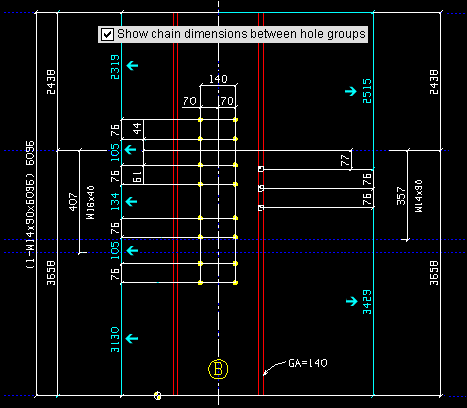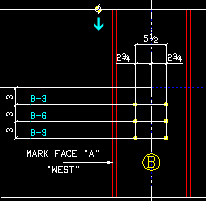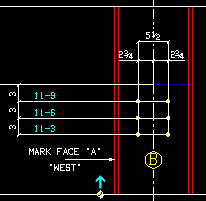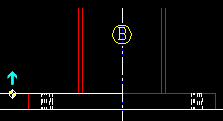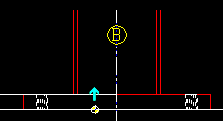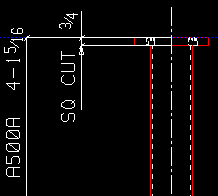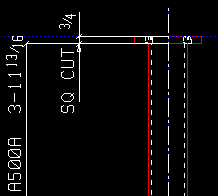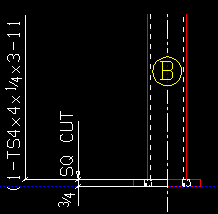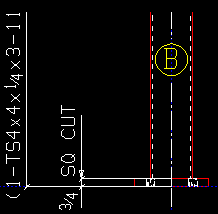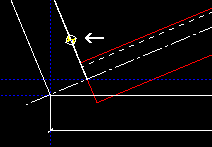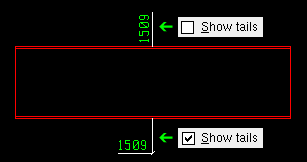The Dimension Settings window ( Fabricator Settings )
- When members (and, in some cases, submaterials) are automatically detailed in a full-featured SDS2 program , the program will look to the Fabricator Settings that you can review on this window to determine how the members (or submaterials) should be dimensioned. Some of the options on this window also affect dimensions added by Site Planning users working in the Drawing Editor .
page 1 | contents | home > project settings > detailing > | classic
Method 1 : Home > Project Settings > Fabricator > Detailing > Dimension Settings .
Methods 2, 3 & 4 : In Modeling or the Drawing Editor , choose Settings > Fabricator Settings > Dimension Settings (classic) , or use a keyboard shortcut , or click the icon.
page 1 | contents | home > project settings > detailing > | classic | top
| General | Beam | Column | Brace | Miscellaneous |
Dimension terminals: Arrow or Slash . The selection shown here applies to all drawings that currently exist in your current Job as well as to yet-to-be-created drawings.
|
Submaterial sloping hole layout dimensions to: Farthest hole or On workline or Nearest hole or None . The selection shown here sets the dimensioning reference point for the sloping hole group of a submaterial. This applies during automatic detailing of members in a full-featured SDS2 program .
|
The ' Farthest hole ' is the hole in the submaterial that is farthest from the workline of the member depicted in the detail. ' On workline ' refers to the work line of the framing member, not the member in the detail. The ' Nearest hole ' is the hole that is closest to the member's workline.
' None ' turns off dimensioning of this type. None of the dimensions shown in the above illustrations are generated during Detail Members when ' None ' is selected.
Main material sloping hole layout dimensions to: Farthest hole or On workline or Nearest hole or None . The dimensions shown in the following illustrations were adjusted to save space. Also, dimensions not controlled by this field were deleted. The selection shown here applies during automatic detailing of members in a full-featured SDS2 program .
|
The ' Farthest hole ' is the hole in the main material that is farthest from the work line of the member. ' On workline ' refers to the work line of the framing member, not the member in the detail. The ' Nearest hole ' is the hole that is closest to the member's workline.
' None ' turns off dimensioning of this type. None of the dimensions shown in the above illustrations are generated during Detail Members when ' None ' is selected. However, " Main material sloping hole extension dimensions " may still apply.
Main material sloping hole extension dimensions: Top, left hole and/or Bottom, left hole and/or Bottom, right hole and/or Top, right hole . The dimensions shown in the following illustrations were adjusted to save space. Also, dimensions not controlled by this field were deleted. The selection shown here applies during automatic detailing of members in a full-featured SDS2 program .
|
Note 1: These buttons control the dimension from the workline of the member to the hole as well as the position of the extension dimensions. When selected, the buttons turn blue. Any combination of the buttons may be selected
Note 2: These options may be used when " Main material sloping hole layout dimensions to " is set to ' None ' or ' Farthest hole ' or etc.
Note 3: If one or more of these buttons are selected, the program draws extension dimensions even if " Show extension dimensions " is not checked.
Show point to point distance on main dimension: ![]() or
or ![]() . The selection shown here applies during automatic detailing of members in a full-featured SDS2 program .
. The selection shown here applies during automatic detailing of members in a full-featured SDS2 program .
|
|||
| Point to point distance is the distance between the two work points of the member. It is equal to the overall dimension plus the minus dimension. |
If this box is checked (
), the point to point distance will be shown in parenthesis on the main dimension line on subsequently detailed members.
If the box is not checked (
), the point to point distance will not be shown.
Show material grade on main dimension: ![]() or
or ![]() . The selection shown here applies during automatic detailing of members in a full-featured SDS2 program .
. The selection shown here applies during automatic detailing of members in a full-featured SDS2 program .
|
If this box is checked (
), the steel grade of the member's main material will be shown on the main dimension of its detail.
If the box is not checked (
), the steel grade will not be shown.
Show angle dimension for arc dimensions: No or as Degrees or as Radians or as Degrees, Minutes and Seconds . In Site Planning, this affects Objects > Arc Dimensions > Add in the Drawing Editor .
' No '
' as Degrees ' ' as Radians ' ' as Degr, Min, Sec ' ' No ' sets angle dimensions to not be displayed by default. In the Drawing Editor , you can override this setting on individual arc dimensions by checking the box for '
Angle ' in the Edit Arc Dimension window.
' as Degrees ' sets angle dimensions to be measured in degrees.
' as Radians ' sets angle dimensions to be measured in degrees.
' as Degrees, Minutes and Seconds ' sets angle dimensions to be measured in degrees.
Show "on radius" dimension for arc dimensions: ![]() or
or ![]() . This applies in the Drawing Editor when you (or anybody else using this Fabricator file) does a Objects > Arc Dimensions > Add operation to a drawing.
. This applies in the Drawing Editor when you (or anybody else using this Fabricator file) does a Objects > Arc Dimensions > Add operation to a drawing.
|
If this box is checked (
), both the radius of the arc and the distance on the circle between the two points being measured will be displayed on subsequently added arc dimensions.
If the box is not checked (
), only the distance on the circle between the two points being measured will be displayed on subsequently added arc dimensions.
Break dimension lines at label interference: ![]() or
or ![]() . The selection shown here applies to all drawings that currently exist in your current Job .
. The selection shown here applies to all drawings that currently exist in your current Job .
|
If this box is checked (
), dimension lines are discontinuous (invisible) where they overlap interfering labels or dimension labels. The dimension line remains a single entity, not divided into segments. If the interfering label or dimension label is Moved or Erased so that the original interference no longer exists, only a Redraw is needed to have the dimension line displayed as a continuous, unbroken line. To override this choice on individual drawings : The settings " Breakable dimension leg(s) " ( Edit Dimension window) and " Breaks lines " ( Label Edit window) and " Breaks lines " ( Edit Dimension window) can be reset on details to override the breaking of lines.
If the box is not checked (
), dimension lines are drawn through overlapping labels or dimension labels.
Break material lines at label interference: ![]() or
or ![]() . The selection shown here applies to all drawings that currently exist in your current Job .
. The selection shown here applies to all drawings that currently exist in your current Job .
|
If this box is checked (
), polygon sides (material lines) and lines are discontinuous (invisible) where they overlap interfering labels or dimension labels. To override this choice on individual drawings : The settings " Breakable " ( Polygon Sides Edit window) and " Breaks lines " ( Label Edit window) and " Breaks lines " ( Edit Dimension window) can be reset in the Drawing Editor to override the choice made here.
If the box is not checked (
), polygon sides and lines are drawn through overlapping labels or dimension labels.
Break bevel lines at label interference: The selection shown here applies to all drawings that currently exist in your current Job .
|
If this box is checked (
), the bevel lines of bevel symbols become discontinuous (invisible) where they overlap interfering labels or dimension labels. Each line remains a single entity; it is not be divided into segments. This applies to all labels and dimension labels placed over bevel lines, regardless of whether they are placed interactively or system-generated. Also see : The settings " Breakable " ( Bevel Symbol window) and " Breaks lines " ( Label Edit window) and " Breaks lines " ( Edit Dimension window) can be set on details to override the choice made here.
If the box is not checked (
), the bevel lines of bevel symbols are drawn through overlapping labels or dimension labels. Tip: If you allow overlapping, you'll probably want to print labels and dimension labels with a wide pen. Home > Project Settings > Fabricator > Line Weights sets the line thickness per drawing pen for best results when printing.
Combine dimensions across detail: ![]() or
or ![]() . The selection shown here applies during automatic detailing of members and submaterials in a full-featured SDS2 program .
. The selection shown here applies during automatic detailing of members and submaterials in a full-featured SDS2 program .
|
If this box is checked (
), dimensions between rows of holes in distinct hole groups will be combined where possible. Member or submaterial details may take up less space as a result.
If the box is not checked (
), the dimensions between rows of holes in distinct hole groups will be dimensioned separately.
Extension dimensions on submaterial details: ![]() or
or ![]() . The selection shown applies during automatic detailing of submaterials in a full-featured SDS2 program .
. The selection shown applies during automatic detailing of submaterials in a full-featured SDS2 program .
|
Extension dimension tails on submaterial details: ![]() or
or ![]() . This applies during automatic detailing of submaterials in a full-featured SDS2 program if the box is checked for " Extension dimensions on submaterial details ."
. This applies during automatic detailing of submaterials in a full-featured SDS2 program if the box is checked for " Extension dimensions on submaterial details ."
|
If this box is checked (
), the program draws extension dimensions with tails where they fit. In general, the extension dimensions with tails are placed at the beginning of new hole groups.
If the box is not checked (
), the program draws extension dimensions parallel with dimension lines. If they fit, the extension dimensions are placed at each hole dimension line along the length of the material.
Material point dimension holdback distance: Any distance from 0 to 2 inches ( 0 to 51 mm metric ) that dimension extension lines are to be held back from the material. The selection shown here applies during automatic detailing of members and submaterials in a full-featured SDS2 program and also to Add Dimension operations in Site Planning.
|
------ Drawing Editor system-generated details and submaterial details restrictions ------
Lock outline layer: ![]() or
or ![]() . On drawings other than crane placement drawings , users of Site Planning restricted from making changes to non-comment layers such as the outline layer regardless of the choice that is made here.
. On drawings other than crane placement drawings , users of Site Planning restricted from making changes to non-comment layers such as the outline layer regardless of the choice that is made here.
|
If the outline layer is locked at the time that a detail is generated, users of a full-featured SDS2 program are unable to alter it. This ensures that materials on the detail exactly represent their appearance in the 3D model. |
If this box is checked (
), users of a full-featured SDS2 program cannot make changes to materials, holes, bolts, or etc. that are on subsequently detailed member details or submaterial details.
If the box is not checked (
), users of a full-featured SDS2 program can, for example, move holes or bolts on member or submaterial details, thus allowing them to make adjustments on shop drawings without first changing the model.
Lock manual editing of dimension text: This applies to all dimensions on comment layers that are on auto-detailed member details and submaterial details in your current Job. This does not apply to user-created member details, which can be created using the " New... " button.
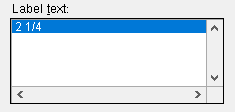
|
When the " Label text " is locked, other settings on the Edit Dimension window remain editable. |
If this box is checked (
), Site Planning users cannot manually edit " Label text " on any dimensions that they add to comment layers on auto-detailed member details or submaterial details. On the Drawing Data window, there is an option that lets you temporarily " Override Drawing Editor restriction options ." Also, you can still drag a dimension leg to change the calculated dimension " Label text ." This ensures that the dimension " Label text " is always accurately calculated to reflect the distance between the points being measured.
If the box is not checked (
), you can freely edit " Label text " on auto-detailed member details and submaterial details, just like they can on other types of drawings. You still cannot edit dimensions on non-comment layers .
Display measurement unit for angle dimensions: ![]() as Degrees or
as Degrees or ![]() as Radians . An angle dimension includes " Label text " that is based on the arc between the two lines that the angle dimension is drawn between. " Display measurement unit for angle dimensions " sets whether the value for the " Label text " is calculated and expressed in degrees or radians.
as Radians . An angle dimension includes " Label text " that is based on the arc between the two lines that the angle dimension is drawn between. " Display measurement unit for angle dimensions " sets whether the value for the " Label text " is calculated and expressed in degrees or radians.
|
'
as Degrees ' causes the " Label text " for newly added angle dimensions to be a number of degrees. The text will include the degree symbol (°).
'
as Radians ' causes the " Label text " for newly added angle dimensions to be a number of degrees. The text will include the word "radians".
Setup override : The " Measurement units " option on the Edit Angle Dimensions window is always set to the choice made here (' Degrees ' or ' Radians ') when an angle dimension is first added. After the angle dimension is added, the " Measurement units " can be changed.
Angle dimension precision: 0 or 1 or 2 or 3 or 4 . The number of places after the decimal point to which a calculated angle dimension will be rounded.
|
| Same Angle, Different Precisions | ||
| Precision | Degrees | Radians |
| 0 | 36 | 1 |
| 1 | 36.0 | 0.6 |
| 2 | 36.01 | 0.63 |
| 3 | 36.014 | 0.629 |
| 4 | 36.0140 | 0.6286 |
' 0 ' results in the angle dimension being expressed as a whole number. You might want to enter 0 as the precision if your " Display measurement unit for angle dimensions " is ' as Degrees '.
' 1 ' results it the angle dimension being expressed with 1 place after the decimal point (e.g., 36.0° or 0.6 radians).
' 2 ' results it the angle dimension being expressed with 1 place after the decimal point (e.g., 36.01° or 0.63 radians). This is the default since it allows sufficienct precision for switching between degrees and radians.
page 1 | contents | home > project settings > detailing > | classic | top
| General | Beam | Column | Brace | Miscellaneous |
Show extension dimensions: ![]() or
or ![]() . Extension dimensions are also known as running dimensions.
. Extension dimensions are also known as running dimensions.
|
If this box is checked (
), then auto detailing in a full-featured SDS2 program will generate extension dimensions on subsequently detailed beams.
If the box is not checked (
), extension dimensions will not be shown on details of beams that are subsequently generated during the automatic detailing in a full-featured SDS2 program .
Show extension dimension tails: ![]() or
or ![]() .
.
|
If this box is checked (
) and the box to " Show extension dimensions " on beam details is also checked, then the extension dimensions that auto detailing subsequently generates for beams will have tails. Also, if you Open a drawing of a beam in the Drawing Editor while this box is checked, the " Extension dimension type " will be set to ' Tails shown '.
If the box is not checked (
), extension dimension will not be shown with tails on details of beams that are subsequently generated during the automatic detailing in a full-featured SDS2 program . Also, if you Open a drawing of a beam in the Drawing Editor , the " Extension dimension type " will be set to ' Tails not shown '.
Show extension dimension origin: ![]() or
or ![]() .
.
|
If this box is checked (
), then auto detailing in a full-featured SDS2 program will, for subsequently detailed beams, draw a small target (
) to designate the point of origin for extension dimensions.
If the box is not checked (
), the origin symbol will not be shown on details of beams that are subsequently generated during the automatic detailing in a full-featured SDS2 program .
Dimension reference point on symmetrical web holes: ![]() or
or ![]() .
.
|
If this box is checked (
), auto detailing routines in a full-featured SDS2 program will, for subsequently detailed beams, dimension the distance between the dimension reference point and the columns of holes in the web hole group associated with that reference point.
If the box is not checked (
) during the automatic detailing of beams, the program may dimension to the hole group dimension point (as shown), but will not dimension the distance between that point and the columns of web holes.
Tip : To find a hole group's reference point in Modeling , use the Verify Reference Point command.
Dimension reference point on symmetrical flange holes: ![]() or
or ![]() .
.
|
If this box is checked (
), auto detailing in a full-featured SDS2 program will, for subsequently detailed beams, dimension the distance between the dimension reference point and the holes in the hole group associated with that reference point.
If the box is not checked (
), automatic detailing will not dimension the distance between the reference point and the holes.
Tip: To find a hole group's reference point in Modeling , use the Verify Reference Point command.
Show chain dimensions between hole groups: ![]() or
or ![]() .
.
|
If this box is checked (
), auto detailing in a full-featured SDS2 program will, for subsequently detailed beams, generate dimensions from the end of the first hole group to the beginning of the next hole group, and so on . . .
If the box is not checked (
), automatic detailing will not show the "chain dimensions" between hole groups.
Show extension dimension from: Left or Right . The selection shown here applies to any beams whose piecemarks are selected during automatic detailing of members in a full-featured SDS2 program .
|
Extension dimensions from (bolted connection): End of beam or Face of connection . The selection shown here applies to beams with bolted end connections whose piecemarks are selected during automatic detailing of members in a full-featured SDS2 program . Extension dimensions for beams with bolted connections will be calculated from the position specified here.
|
||||
| For both of these examples, the box is checked for " Show extension dimension origin ." The origin symbol is placed (during auto detailing) from the ' End of beam ' or ' Face of connection '. |
Extension dimensions from (welded connection): End of beam or Face of conn . The selection shown here applies to any beams with welded end connections whose piecemarks are selected during automatic detailing of members in a full-featured SDS2 program . Extension dimensions for beams with welded connections will be calculated from the position specified here.
|
||||
| For both of these examples, the box is checked for " Show extension dimension origin ." The origin symbol is placed (during auto detailing) from the ' End of beam ' or ' Face of connection '. |
Copes dimensioned from: End of beam or Face of conn . The selection shown here applies to any beams with copes whose piecemarks the user selects during automatic detailing of members in a full-featured SDS2 program .
|
Show end of beam to face of clip angle dimension: ![]() or
or ![]() . The selection shown here applies to any beams with clip angles whose piecemarks are selected for automatic detailing in a full-featured SDS2 program .
. The selection shown here applies to any beams with clip angles whose piecemarks are selected for automatic detailing in a full-featured SDS2 program .
|
If this box is checked (
), the dimension from the face of the clip angle to the end of the member will be drawn on details of beams that are subsequently generated in a full-featured SDS2 program .
If the box is not checked (
), this dimension will not be calculated or shown on subsequently generated details of beams.
page 1 | contents | home > project settings > detailing > | classic | top
| General | Beam | Column | Brace | Miscellaneous |
Show extension dimensions: ![]() or
or ![]() . Extension dimensions are also known as running dimensions.
. Extension dimensions are also known as running dimensions.
|
If this box is checked (
), then auto detailing in a full-featured SDS2 program will generate extension dimensions on subsequently detailed columns.
If the box is not checked (
), extension dimensions will not be shown on details of columns that are subsequently generated during the automatic detailing .
Show extension dimension tails: ![]() or
or ![]() .
.
|
If this box is checked (
) and the box to " Show extension dimensions " on column details is also checked, then the extension dimensions that auto detailing routines subsequently generate for columns will have tails. Also, if you Open a drawing of a column in the Drawing Editor while this box is checked, the " Extension dimension type " will be set to ' Tails shown '.
If the box is not checked (
), extension dimension will not be shown with tails on details of columns that are subsequently generated during automatic detailing in a full-featured SDS2 program . Also, if you Open a drawing of a column in the Drawing Editor , the " Extension dimension type " will be set to ' Tails not shown '.
Show extension dimension origin: ![]() or
or ![]() .
.
|
If this box is checked (
), then auto detailing in a full-featured SDS2 program will, on subsequently detailed columns, draw a small target (
) to designate the point of origin for extension dimensions.
If the box is not checked (
), the origin symbol will not be shown on details of columns that are subsequently generated during the automatic detailing in a full-featured SDS2 program .
Dimension reference point on symmetrical web holes: ![]() or
or ![]() .
.
|
If this box is checked (
), auto detailing in a full-featured SDS2 program will, for subsequently detailed columns, dimension the distance between the dimension reference point and holes in the web hole group associated with that reference point.
If the box is not checked (
) during the automatic detailing of columns in a full-featured SDS2 program , the program will not dimension between the reference point and the web holes.
Tip: To find a hole group's reference point in Modeling , use the Verify Reference Point command.
Dimension reference point on symmetrical flange holes: ![]() or
or ![]() .
.
|
If this box is checked (
), auto detailing in a full-featured SDS2 program will, for subsequently detailed columns, dimension the distance between the dimension reference point and the holes associated with that point.
If the box is not checked (
) during the automatic detailing of columns in a full-featured SDS2 program , the program may dimension to the hole group dimension point (as shown), but will not dimension the distance between that point and the holes.
Tip: To find a hole group's reference point in Modeling , use the Verify Reference Point command.
Show chain dimensions between hole groups: ![]() or
or ![]() . This applies during the automatic detailing of columns in a full-featured SDS2 program . If the box is checked (
. This applies during the automatic detailing of columns in a full-featured SDS2 program . If the box is checked ( ![]() ), then dimensions will be added from the end of the first hole group to the beginning of the next hole group, and so on . . .
), then dimensions will be added from the end of the first hole group to the beginning of the next hole group, and so on . . .
|
Show extension dimensions from: Top or Bottom . The selection shown here applies to columns whose piecemarks are selected for automatic detailing in a full-featured SDS2 program .
|
Extension dimensions from: Top of plate or Bottom of plate . The selection shown here applies to any columns with base or cap plates whose piecemarks are selected for automatic detailing in a full-featured SDS2 program .
|
Overall dimensions from (cap plate): Top of plate or Bottom of plate . The selection shown here applies to any columns with cap plates whose piecemarks are selected for automatic detailing in a full-featured SDS2 program .
|
Overall dimensions from (base plate): Bottom of plate or Top of plate . The selection shown here applies to any columns with base plates whose piecemarks are selected for automatic detailing in a full-featured SDS2 program .
|
page 1 | contents | home > project settings > detailing > | classic | top
| General | Beam | Column | Brace | Miscellaneous |
------ Horizontal braces ------
| These options apply to horizontal braces. See below for documentation on similar options that apply to vertical braces. |
Show extension dimensions: Same as " Show extension dimensions " for vertical braces, except that this option applies to horizontal braces.
Show extension dimension tails: Same as " Show extension dimension tails " for vertical braces, except that this option applies to horizontal braces.
Effect on dimensions added in Site Planning : The default for " Show tails ," which applies to user-added dimensions, matches the choice made here (checked or not checked) if the drawing is a horizontal brace.
Show extension dimension origin: Same as " Dimension extension dimension origin " for vertical braces, except that this option applies to horizontal braces.
Dimension reference point on symmetrical web holes: Same as " Dimension reference point on symmetrical web holes " for vertical braces, except that this option applies to horizontal braces.
Dimension reference point on symmetrical flange holes: Same as " Dimension reference point on symmetrical flange holes " for vertical braces, except that this option applies to horizontal braces.
Show chain dimensions between hole groups: Same as " Show chain dimensions between hole groups " for vertical braces, except that this option applies to horizontal braces.
Show extension dimensions from: Same as " Show extension dimensions from " for vertical braces, except that this option applies to horizontal braces.
page 1 | contents | home > project settings > detailing > | classic | top
| These options apply to vertical braces. See above for documentation on similar options that apply to horizontal braces. |
Show extension dimensions: ![]() or
or ![]() . Extension dimensions are also known as running dimensions.
. Extension dimensions are also known as running dimensions.
|
If this box is checked (
), automatic detailing in a full-featured SDS2 program generates extension dimensions on vertical brace details.
If the box is not checked (
), extension dimensions will not be shown on details of vertical brace details that are generated the next time a full-featured SDS2 program user auto details.
Show extension dimension tails: ![]() or
or ![]() .
.
|
If this box is checked (
) and the box is checked for " Show extension dimensions " is also checked for vertical braces, then automatic detailing in a full-featured SDS2 program adds tails to the extension dimensions on vertical brace details that it generates.
If the box is not checked (
), extension dimension will not be shown with tails on details of vertical braces that are generated the next time auto detailing takes place.
Effect on dimensions added in Site Planning : The default for " Show tails ," which applies to user-added dimensions, matches the choice made here (checked or not checked) if the drawing is a vertical brace.
Show extension dimension origin: ![]() or
or ![]() .
.
|
If this box is checked (
), automatic detailing in a full-featured SDS2 program draws a small target (
) to show the point of origin for extension dimensions on vertical braces.
If the box is not checked (
), the origin symbol are not shown on details of vertical braces that are generated the next time auto detailing takes place.
Dimension reference point on symmetrical web holes: ![]() or
or ![]() .
.
|
If this box is checked (
), automatic detailing in a full-featured SDS2 program dimensions the distance between the hole group reference point and the columns of holes in symmetrical web hole groups on vertical braces.
If the box is not checked (
), automatic detailing does not dimension the distance between the hole group reference point and the columns of web holes on vertical braces.
Dimension reference point on symmetrical flange holes: ![]() or
or ![]() .
.
|
If this box is checked (
), automatic detailing (in a full-featured SDS2 program ) dimensions the distance between the hole group reference point and the symmetrical flange holes on vertical braces.
If the box is not checked (
) automatic detailing does not dimension the distance between the hole group reference point and the symmetrical flange holes on vertical braces.
Show chain dimensions between hole groups: ![]() or
or ![]() .
.
|
If this box is checked (
), then -- for vertical braces -- automatic detailing (in a full-featured SDS2 program ) dimensions from the end of the first hole group to the beginning of the next hole group, and so on . . .
If the box is not checked (
), then -- for vertical braces -- automatic detailing does not generate "chain dimensions" between hole groups.
Show extension dimensions from: Left or Right . The selection shown here applies to braces whose piecemarks are selected during automatic detailing of members in a full-featured SDS2 program .
| Extension dimensions from left : |
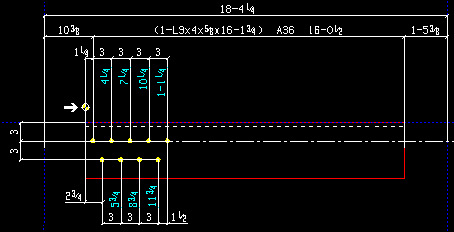
|
| Extension dimensions from right : |
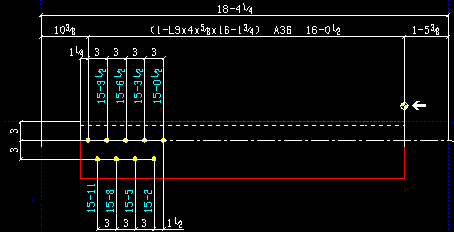
|
page 1 | contents | home > project settings > detailing > | classic | top
| General | Beam | Column | Brace | Miscellaneous |
Show extension dimension tails: ![]() or
or ![]() .
.
|
If this box is checked (
) and you Open a drawing of a miscellaneous member in the Drawing Editor , the " Extension dimension type " will be set to ' Tails shown '.
If the box is not checked (
) and you Open a drawing of a miscellaneous member in the Drawing Editor , the " Extension dimension type " will be set to ' Tails not shown '.
------ Rolled plate widths ------
Rolled plate width dimension taken from: Outside or Center or Inside . This affects the " Unrolled width " of a rolled plate and is used in the material " Description " on the General Information window and in the " Description " in the member bill of material. The " Unrolled width " of the plate is also included in the plate section callout on the plate's submaterial detail .
| ' Outside ' | ' Center ' | ' Inside ' |
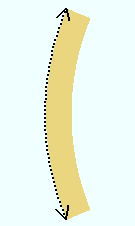
|
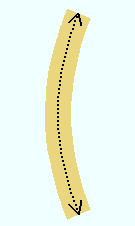
|
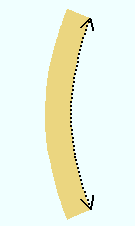
|
' Outside ' causes the " Unrolled width " of the rolled plate to be measured along the outside arc of the roll. This is the choice that is selected by default since it is most compatible with the way that a rolled plate is added in the model.
' Center ' causes the " Unrolled width " of the rolled plate to be measured along the neutral axis of the rolled plate.
' Inside ' causes the " Unrolled width " of the rolled plate to be measured along the inside arc of the roll.
------ Bent plate lengths ------
Bent plate lengths calculated: ![]() At centerline for all plate thickness or
At centerline for all plate thickness or ![]() Custom K factors . .The choice made here affects the " Descriptiion " on the General Information window in Modeling and the " Description " in the member bill of material.
Custom K factors . .The choice made here affects the " Descriptiion " on the General Information window in Modeling and the " Description " in the member bill of material.
|
'
At centerline for all plate thickness ' is the default and represents the method that SDS2 programs have traditionally used to calculate bent plate lengths. Per LRFD 3rd Edition, p 10-173, "The length of the plate is measured on its mid-thickness, without regard to the radius of its bend."
'
Custom K factors ' instructs a full-featured SDS2 program to use the K factor in the "Custom K factors" table to calculate the length of a bent plate. In that table, the K factor is associated with a plate's thicknkess.
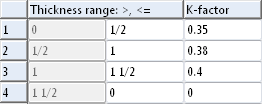
The "Custom K factors" table . A "K factor" is a ratio that quantifies how the thickness of a bent plate material is distributed around its neutral axis.
page 1 | contents | home > project settings > detailing > | classic | top
